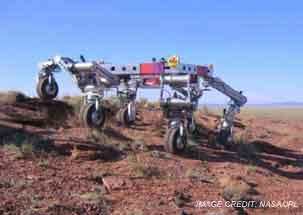Wheel Legged Robots (Hybrid Robots)
Using wheels or legs in your robot have their own advantages and disadvantages. Wheels can make your robot move faster, are easier to design and build. Legged robots on the other hand are excellent on uneven surfaces and rough terrain. An intelligent robot builder would appreciate the merits of both wheels and legs and somehow combine them in a robot to reflect the merits of each. 
Wheel-legged robots are irregular robots with multiple degrees of freedom based on the design. Depending on the requirement and environment, these robots may either use legs or wheels, or both if necessary.
In an ideal wheel-legged robot, the default responsibility of movement lies on its wheels. This helps the robot move faster. Once it senses an uneven surface, or a surface which is difficult for the wheels to traverse, legs take control. As complex as it sounds, Wheel-legged robots are difficult to design and build since it has to incorporate the coordination of wheels, coordination of legs and coordination of wheels and legs.
Image shows ATLETE, a wheel-legged robot which rolls on even surface and uses it as legs when walking on rough terrain.
Other kinds of locomotion
Although legs and wheels are commonly used in robots, there are few other ways which has inspired the robotics community; most of them biologically inspired.
Crawler Robots: As the name says, it crawls. Typical snake robots (robots built to resemble a snake) use this technique
Jumping or Hopping Robot: One legged robots are a good example of hopping or jumping robots. However there are other robots with two, three, or more legs which hop from one location to another. I have seen a wheeled robot which rolls on a flat surface and jumps when it finds an obstacle.
Rolling Robots: These are huge spherical robots just keep rolling to create movement. Although they might not be as interesting as other robots, they do exist.
The above mentioned are just a few of the many available means for land based robot movement. A creative robot enthusiast might come up with a very new unheard design which may become a new standard for robot locomotion (as always expected).
Do you have anything to say?
Visit the Forum to discuss, learn and share anything related to robotics and electronics !!








